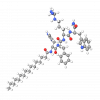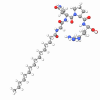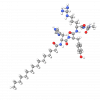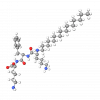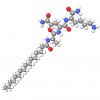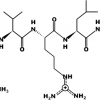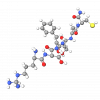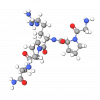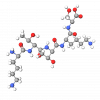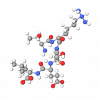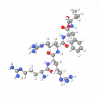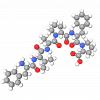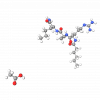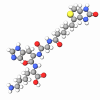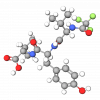Palmitoyl sh-Tripeptide-4 Amide is a low molecular weight lipo-peptide (316.3 Da) derived from CD99, an anti-inflammatory molecule that is expressed in all human cells. It is also known under the trade name Binterin™.
Peptides
There are numerous examples in physiology of peptide regulatory elements that play integral roles in basic homeostatic mechanisms such as injury-repair responses and other stimulus-response actions. Among these are well-known neuropeptides (e.g., bradykinins, endorphins); metabolism and fat storage regulators (e.g., neuropeptide Y, leptin, insulin); tanning and skin pigmentation-related peptides (e.g., α-MSH, ACTH, Agouti), and peptides involved in wound healing (e.g., FGF).
This large group of innovative cosmeceutical ingredients triumphed in the world of skincare products during the last two decades. Peptides are chains of amino acids that are attached in a specific order. Amino acids are naturally occurring in the body and are vital to everyday living processes. Peptides can be made up of 2 or more amino acids that can stimulate different responses within the body. As a result, peptides serve as tiny messengers that can be sent to kick the skin into gear and make it look better.
Peptides are leading a beauty revolution due to their excellent multi-functional properties; formularies are scrambling to access the latest advances in cosmetic peptide technology. In addition, their "Botox-like" performance, activation of collagen and elastin production, and skin-lightening effect make them very efficient against coarse wrinkles and hyperpigmentation of the skin.
Palmitoyl Sh-Tripeptide-5 Norisoleucyl Sh-Nonapeptide-1 is a lipo-peptide that acts as an antagonist of
Palmitoyl Tetrapeptide-20 is a biomimetic lipo-peptide with sequence Pal-His-Phe-Arg-Trp-NH2 that mimics α-MSH (alpha Melanocyte Stimulating Hormone) by binding the MC1-R (melanocortin 1 receptor) and stimulating melanin production.
Palmitoyl Tetrapeptide-72 Amide is a synthetic lipo-peptide with sequence Pal-His-Tyr-Arg-Ala-NH2 that boosts expression and production of Mohawk, a homeodomain protein abundantly expressed in the young skin and actively involved in the regeneration of EMC components and connective tis
Palmitoyl tripeptide-28 is a peptide ingredient based on TGF-β (Transforming growth factor beta) that mimics cytokine action by binding with specific receptors (TGF beta receptor 2) on fibroblast membrane, stimulating the production of extracellular matrix (ECM) components.
Palmitoyl Tripeptide-36 is a synthetic lipo-peptide known under the trade name DermaPep™ M330 that exhibits anti-microbial activity. It inhibits the growth of Staphylococcus aureus and other bacteria, and fungi. Peptide sequence is Palmitoyl-Lys-Met(O2)-Lys-OH.
Palmitoyl Tripeptide-37 is a synthetic lipo-peptide with sequence Pal-KFK (Palmitoyl-Lys-Phe-Lys) that leaves thrombospondin-like action. It is an analog of Lipospondin. It is an ester of palmitic acid and Tripeptide-37 (KFK peptide) with an active Thrombospondin domain sequence.
Palmitoyl Tripeptide-53 Amide (known under the trade name Winhibin™) is a low molecular-weight tripeptide derived from Sfrp5 (Secreted frizzled protein5) and known as a modulator adipokine of WNT-signaling.
Pentapeptide-13 is a synthetic peptide that mimics the human Agouti-signaling protein (ASP or ASIP) action. This peptide is also known under the trade name CG-ASP.
Pentapeptide-25 is a synthetic peptide that retreats the sequence (Lys Val Arg Leu GIn) of a member of the UCP family of proteins found in mitochondria. "UCP" refers to a family of Uncoupling Proteins in various human tissues, including adipocytes (fatty cells).
Pentapeptide-29 Cysteinamide is a synthetic hexapeptide derived from keratin (a part of protein amino acid sequence Arg-Ser-Phe-Ser-Ala-Cys) with a terminal Cysteine.
Pentapeptide-3 is a synthetic peptide with the sequence Gly-Pro-Arg-Pro-Ala-NH2 known under the trade name Vialox peptide. It acts as an acetylcholine (ACh) competitive antagonist, blocking the membrane’s receptors and leaving a curare-like effect.
Coenzyme Q10 is present in dermal cells, where it stimulates ATP (cellular energy molecules) production and protects from oxidative damage (free radicals).
Pentapeptide-4 (former Pentapeptide-3) is a synthetic peptide with the sequence KTTKS (Lys-Thr-Thr-Lys-Ser-OH), a fragment of pro-collagen I. It is known under the trade name Micro-Collagen™. It stimulates the production of dermal matrix components by fibroblasts.
Pentapeptide-48 is a synthetic peptide with the sequence Thr-Arg-Ser-Glu-Leu that repeats the active part of the Royalactin protein. Royalactin is a protein found in royal jelly and it is responsible for the epigenetic changes in the larvae's DNA, creating the queen bee phenotype.
Pentapeptide-59 is a synthetic peptide derived from a part of a sequence (Arg-Arg-Arg-Phe-Val) of
It has been well documented that extracts from yeast fermentation, particularly Saccharomyces cerevisiae, have demonstrated wound-healing properties.
Peptiomax® is a trading name for 17 amino acids length synthetic peptide ingredient with the designation Oligopeptide-35. It contains the following amino acids: aspartic acid, glutamic acid, leucine, lysine, methionine, proline, serine, tyrosine, and valine.
PerfectionPeptide P3 is a biomimetic peptide-based complex for peeling to create perfect skin.
Platinum MatrixEM is a synthetic peptide based on TGF (Transforming growth factor) nano-conjugated to platinum particles.
Progeline™ (Trifluoroacetyl Tripeptide-2; sequence: TFA-Val-Try-Val-OH) is a biomimetic peptide-based complex ingredient that mimics a specific protein Elafin responsible for the inhibition of the Elastase enzyme that breaks down elastin.
Quintescine™ IS is a peptide-based complex ingredient that mimics glutathione action leaving antioxidant, anti-glycation, and anti-aging effect on the skin.
Facial moisturizers, nutrient serums, and even daily cleansers claim to contain powerful ingredients that stave off the development of undesirable, yet seemingly inevitable, extrinsic signs of aging - from wrinkles to age spots to sagging skin.
